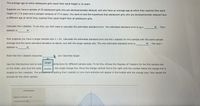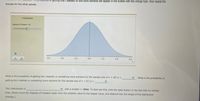
MATLAB: An Introduction with Applications
6th Edition
ISBN: 9781119256830
Author: Amos Gilat
Publisher: John Wiley & Sons Inc
expand_more
expand_more
format_list_bulleted
Question
Need all questions answered.
Options for last question are:
A) flatter and more spread out
B) more like the z distribution

Transcribed Image Text:The average age at which adolescent girls reach their adult height is 16 years.
Suppose you have a sample of 29 adolescent girls who are developmentally delayed, and who have an average age at which they reached their adult
height of 17.8 years and a sample variance of 77.4 years. You want to test the hypothesis that adolescent girls who are developmentally delayed have
a different age at which they reached their adult height than all adolescent girls.
Calculate the t statistic. To do this, you first need to calculate the estimated standard error. The estimated standard error is SM=
The t
statistic is
Now suppose you have a larger sample size n = 91. Calculate the estimated standard error and the t statistic for this sample with the same sample
average and the same standard deviation as above, but with the larger sample size. The new estimated standard error is
The new t
statistic is
Note that the t statistic becomes
as n becomes larger.
larger
Use the Distributions tool to look
stributions for different sample sizes. To do this, choose the Degrees of Freedom for the first sample size
on the slider, and click the radio
smaller h the single orange line. Move the orange vertical line to the right until the number below the orange line is
located on the t statistic. The probovmty ur getting that t statistic or one more extreme will appear in the bubble with the orange type. Now repeat the
process for the other sample.
t Distribution
Degrees of Freedom 52

Transcribed Image Text:probabmey or getting that t statistic or one more extreme will appear in the bubble with the orange type. Now repeat the
process for the other sample.
t Distribution
Degrees of Freedom 62
-3.0
-2.0
-1.0
0.0
1.0
2.0
What is the probability of getting the t statistic or something more extreme for the sample size of n = 29? p =
What is the probability of
getting the t statistic or something more extreme for the sample size of n = 91?p3D
The t distribution is
with a smaller n. (Hint: To best see this, click the radio button in the tool with no vertical
lines. Slowly move the Degrees of Freedom slider from the smallest value to the largest value, and observe how the shape of the distribution
changes.)
Expert Solution
This question has been solved!
Explore an expertly crafted, step-by-step solution for a thorough understanding of key concepts.
This is a popular solution
Trending nowThis is a popular solution!
Step by stepSolved in 2 steps

Knowledge Booster
Learn more about
Need a deep-dive on the concept behind this application? Look no further. Learn more about this topic, statistics and related others by exploring similar questions and additional content below.Similar questions
- A survey asks questions about one's happiness and health. One would think that health plays a role in one's happiness. Use the data in the accompanying table to determine whether healthier people tend to also be happier. Treat level of health as the explanatory variable. E Click the icon to view the data table. Create a conditional distribution for the data. Level of Health Data table Level of Happiness Not too happy Poor Fair Good Excellent Poor Fair Good Excellent Pretty happy Not too happy Pretty happy Very happy 1,376 1,629 9,642 696 732 Very happy 950 3,817 5,185 345 1,372 4,520 5,085 Total (Round to three decimal places as needed.) Print Donearrow_forwardVineyards Here are summary statistics for the sizes (inacres) of Finger Lakes vineyards:a) Would you describe this distribution as symmetric orskewed? Explain.b) Are there any outliers? Explain.c) Create a boxplot of these data.d) Write a few sentences about the sizes of thevineyards.arrow_forwardThe table gives information on majors at a certain college. Sketch an appropriate graph of the distribution, and comment on its important features. Click the icon to view the table of majors information. One type of graph appropriate for showing this distribution is a bar chart. Which of the following bar charts correctly shows the given distribution? ○ A. Porcentage О в. Q 50- 50- 40- 40- 30- 20 30- 20- G 10- 10- 0+ 0+ HSS MS T Major H'SS'MS' T Major A. Pie chart ○ C. 50- Q 40- Percentage 30- 20 10- 0+ HSS MSI Major Which of the following would also be appropriate graphs for showing the given distribution? Select all that apply. ☐ ☐ ☐ ☐ B. Stemplot C. Pareto chart D. Histogram E. Dotplot F. None of the above Which of the following is the best description of the distribution's important features? OA. The mode is Social Science (SS). OB. The mode is Humanities (H). Majors ○ D. 50- Q Percentage 40- 30- 20- 10- 0+ H SS MSI Major Major H. Humanities SS. Social Science Percentage 39 17 MS.…arrow_forward
- NEED HELP WITH: E,F,Garrow_forwarda. Use technology to produce a dotplot and b a histogram of this distribution. Try a few different histograms, with varying subintervals, to find the one that you consider the best summary of the distribution. b. Write a few sentences describing the shape, center, and spread of this distribution.arrow_forwardGiven the following distribution of scores: 2, 8, 2, 3, 6, 5, 7, 8, 4, 8, 2, 3 What is the mode of the distribution? Group of answer choices 2 8 Both 5 and 7 Both 2 and 8arrow_forward
- Can you please answer , b, d , g Thank youarrow_forwardThe table below shows the scores of a group of students on a 10-point quiz. Frequency Test Score 3 4 5 6 7 8 9 10 2 3 0 3 3 3 4 4 The mean score on this test is: The median score on this test is:arrow_forwardThe grades on the second statistics test for Ms. Rose's class are in the following list. Complete the frequency distribution table for the grades. 1. B, C, D, F, A, D, C, A, D, D, D, B, D, C, D, B, D, A, B, F, D Grade Frequency A D Farrow_forward
arrow_back_ios
arrow_forward_ios
Recommended textbooks for you
 MATLAB: An Introduction with ApplicationsStatisticsISBN:9781119256830Author:Amos GilatPublisher:John Wiley & Sons Inc
MATLAB: An Introduction with ApplicationsStatisticsISBN:9781119256830Author:Amos GilatPublisher:John Wiley & Sons Inc Probability and Statistics for Engineering and th...StatisticsISBN:9781305251809Author:Jay L. DevorePublisher:Cengage Learning
Probability and Statistics for Engineering and th...StatisticsISBN:9781305251809Author:Jay L. DevorePublisher:Cengage Learning Statistics for The Behavioral Sciences (MindTap C...StatisticsISBN:9781305504912Author:Frederick J Gravetter, Larry B. WallnauPublisher:Cengage Learning
Statistics for The Behavioral Sciences (MindTap C...StatisticsISBN:9781305504912Author:Frederick J Gravetter, Larry B. WallnauPublisher:Cengage Learning Elementary Statistics: Picturing the World (7th E...StatisticsISBN:9780134683416Author:Ron Larson, Betsy FarberPublisher:PEARSON
Elementary Statistics: Picturing the World (7th E...StatisticsISBN:9780134683416Author:Ron Larson, Betsy FarberPublisher:PEARSON The Basic Practice of StatisticsStatisticsISBN:9781319042578Author:David S. Moore, William I. Notz, Michael A. FlignerPublisher:W. H. Freeman
The Basic Practice of StatisticsStatisticsISBN:9781319042578Author:David S. Moore, William I. Notz, Michael A. FlignerPublisher:W. H. Freeman Introduction to the Practice of StatisticsStatisticsISBN:9781319013387Author:David S. Moore, George P. McCabe, Bruce A. CraigPublisher:W. H. Freeman
Introduction to the Practice of StatisticsStatisticsISBN:9781319013387Author:David S. Moore, George P. McCabe, Bruce A. CraigPublisher:W. H. Freeman

MATLAB: An Introduction with Applications
Statistics
ISBN:9781119256830
Author:Amos Gilat
Publisher:John Wiley & Sons Inc

Probability and Statistics for Engineering and th...
Statistics
ISBN:9781305251809
Author:Jay L. Devore
Publisher:Cengage Learning

Statistics for The Behavioral Sciences (MindTap C...
Statistics
ISBN:9781305504912
Author:Frederick J Gravetter, Larry B. Wallnau
Publisher:Cengage Learning

Elementary Statistics: Picturing the World (7th E...
Statistics
ISBN:9780134683416
Author:Ron Larson, Betsy Farber
Publisher:PEARSON

The Basic Practice of Statistics
Statistics
ISBN:9781319042578
Author:David S. Moore, William I. Notz, Michael A. Fligner
Publisher:W. H. Freeman

Introduction to the Practice of Statistics
Statistics
ISBN:9781319013387
Author:David S. Moore, George P. McCabe, Bruce A. Craig
Publisher:W. H. Freeman